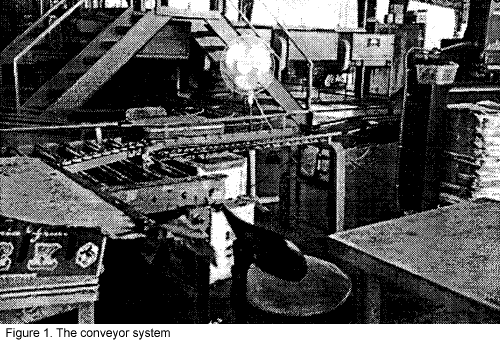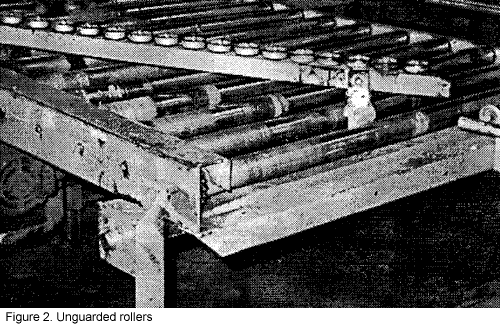A summary of this document is available in english and spanish. (Un resumen de este documento está disponible en inglés y español.)
SUMMARY: CASE 193-209-01
Early one morning a worker was setting up her work station in a packing plant. Her job was to stamp fruit boxes as they moved past her on a roller transport system. First she had to put a hair net on and arrange the stamps on her table. Her table was right next to the roller transport system. As she laid the stamps on the table, one fell on the ground.
The worker began bending over to pick up the stamp. Her hair net was not on yet. Her long, loose hair grazed the fast moving rollers and started tangling in them. The rollers continued pulling her hair in until a large part of her scalp tore off.
Immediately, her supervisor turned off the rollers and wrapped the injured worker's head in a shirt. Co- workers ran to the plant office to call 911. Later, at a hospital doctors tried, but could not reattach the worker's scalp.
How could this injury have been prevented?
BACKGROUND
On June 23, 1993, NURSE staff identified an injury in a packing plant while reviewing records at a Regional Trauma Center. On June 16, 1993, a packing line worker lost 40% of her scalp while setting up her work station area. Her hair became tangled in a roller conveyor system when she bent over to pick up a stamp off the floor.
On July 14, 1993, a nurse from the NURSE Project interviewed the injured worker by telephone. On September 10, 1993, the nurse and a safety engineer conducted an on-site investigation. They also discussed the incident with the plant co-owner and a supervisor who was in the plant during the incident. NURSE staff also reviewed the California Occupational Safety and Health Administration (Cal/OSHA) "Accident Report," the ambulance patient run sheet, and hospital medical records.
The plant co-owner notified Cal/OSHA on June 17, 1993. At the time of this NURSE Report, the Cal/OSHA investigation report was not available.
During the on-site investigation, the safety engineer reviewed the employer's written injury and illness prevention program and noted it addressed all points as required by Title 8 California Code of Regulations 3203 - - Injury and Illness Prevention Program. (As of July 1, 1991 the State of California requires all employers to have a written seven point injury prevention program: 1. designated safety person responsible for implementing the program; 2. mode for ensuring employee compliance; 3. hazard communication; 4. hazard evaluation through periodic inspections; 5. injury investigation procedures; 6. intervention process for correcting hazards; and 7. provide safety training and instruction.)
The incident took place at a packing plant owned and operated by two brothers. It employs 10 full-time workers (working 38+ weeks per year), 30-90 seasonal workers (working 13-37 weeks per year), and 6 family members. The injured packing line worker was hired as a seasonal worker two and one half months before the incident. She stated she had received verbal and written safety training relating to her tasks.
INCIDENT
On June 16, 1993, at approximately 7:50 a.m., a 21 year- old Caucasian female packing line worker was setting up her work station table. Her job task consisted of stamping boxes with the type and size of fruit as they moved past her on a chain driven roller conveyor system. The rollers rotate rapidly to move the boxes down the conveyor system (see Figure 1).

The packing line worker laid the stamps on her work station table, located next to the conveyor belt. One of them fell to the ground. Because she had not yet started her job task, her long hair was not in a hair net. As she bent over to pick up the stamp, her hair became tangled in an unguarded section of the rapidly moving roller conveyor system. Although she tried, the packing line worker could not reach the emergency turn off button approximately 10-12 inches from the roller. The right front section of her scalp tore off.
A supervisor heard the packing line worker screaming. He saw her standing with her face and clothes covered in blood. He quickly shut off power to the roller conveyor system. Certified in first aid, the supervisor wrapped a shirt around her head to control the bleeding. Then, he retrieved the scalp from the roller conveyor system and placed it in a bag on top of ice. Concurrently, co-workers ran into the plant office to call 911.
Emergency Medical Services (EMS) received the call at 8:07 a.m., and arrived on the scene at 8:13 a.m. They applied head pressure dressings, administered oxygen, and started an IV. At 8:29 a.m., the injured packing line worker was transported to a Regional Trauma Center. Arriving at 8:52 a.m., emergency department staff cleaned her exposed skull bone and applied a clean, sterile dressing. She was given pain control medication.
At 10:20 a.m., she was transported, by helicopter, to another medical facility for microsurgery to reattach her scalp. She remained hospitalized for seventeen days and then was released for a holiday weekend. Upon readmission after the holiday, it was apparent the attachment was unsuccessful. The scalp was surgically removed. However, skin grafting surgery was performed in which the top layer of skin was taken from another part of her body and transplanted on her skull. She was released July 13, 1993.
The nurse and the safety engineer from the NURSE Project again met with the injured packing line worker on September 1, 1993. Although she stated she was recovering well and the graft was successful, she did not expect to return to work for at least a year.
PREVENTION STRATEGIES

NURSE
Project
California Occupational Health Program
Berkeley office:
2151 Berkeley Way, Annex 11
Berkeley, California 94704
(510) 849-5150
Fresno office:
1111 Fulton Mall, Suite 212
Fresno, California 93721
(209) 233-1267
Salinas
office:
1000 South Main St., Suite 306
Salinas, California 93901
(408) 757-2892
Publication #: CDHS(OHB)-FI-94-005-31
This document was extracted from a series of the Nurses Using Rural Sentinal Events (NURSE) project, conducted by the California Occupational Health Program of the California Department of Health Services, in conjunction with the National Institute for Occupational Safety and Health. Publication date: January 1994.
The NURSE (Nurses Using Rural Sentinel Events) project is conducted by the California Occupational Health Program of the California Department of Health Services, in conjunction with the National Institute for Occupational Safety and Health. The program's goal is to prevent occupational injuries associated with agriculture. Injuries are reported by hospitals, emergency medical services, clinics, medical examiners, and coroners. Selected cases are followed up by conducting interviews of injured workers, co-workers, employers, and others involved in the incident. An on-site safety investigation is also conducted. These investigations provide detailed information on the worker, the work environment, and the potential risk factors resulting in the injury. Each investigation concludes with specific recommendations designed to prevent injuries, for the use of employers, workers, and others concerned about health and safety in agriculture.
Disclaimer and Reproduction Information: Information in NASD does not represent NIOSH policy. Information included in NASD appears by permission of the author and/or copyright holder. More